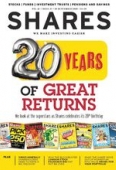Archived article
Please note that tax, investment, pension and ISA rules can change and the information and any views contained in this article may now be inaccurate.
Using ETFs to invest in quality companies

You can use exchange-traded funds (ETFs) to access many different types of shares, grouped according to whatever criteria you like. For example, you can use screening tools to narrow down the ETF universe to those funds which only invest in quality stocks. But what are quality stocks and why would you want to hold them?
Broadly, quality companies are those which use their capital to generate sustainable earnings and maintain strong cash flows in the future. The indicators a quality screen will look for are:
– Profitability
– Earnings quality
– Growth in earnings
– Stable dividend yields
– Low debt
The popularity of this type of stock means many trade on high valuations which arguably makes them riskier investments, particularly in the short term, although over the long term investing in quality businesses is an approach which has merit.
HOW TO FIND ‘QUALITY’ ETFS
On ETF platform JustETF1com, for example, there is an option to search for funds by ‘Fundamental/Quality’. This brings up a list of 27 ETFs, and the platform suggests the ones with ‘quality’ or ‘leaders’ in their name are the ones to investigate further.
Below are the three best performers from that list ranked by percentage terms over three years, to give you an example of what a ‘quality’ ETF screen could give you.
All three names in the table are London-listed US-focused ETFs. Among their top 10 holdings you would find Apple, Microsoft and Facebook, as well as Johnson & Johnson, ExxonMobil, Applied Materials, Comcast and T Rowe Price.
Examples of non-US ‘quality’ ETFs are BMO MSCI UK Income Leaders (ZIEU), iShares Edge MSCI Europe Quality Factor (IEQU) and iShares UK Quality Dividend ETF (IUKD).
So why would you want to screen for quality when selecting an ETF? Peter Sleep, senior portfolio manager at Seven Investment Management, explains why a ‘cult of quality’ has emerged in investment circles over the last decade: ‘When we talk about quality in financial markets, we are talking about companies that have certain characteristics that people find attractive like steady profitability, and often high returns.
‘With a company like Unilever (ULVR), for instance, that makes products we use every day, its profitability does not fluctuate much versus, for example, a steel company which would be enormously cyclical. It would make money in the good times and lose money in the bad times but it would never be steady.
‘Market professionals like myself tend to like quality because a lot of long-term evidence-based research suggests these companies tend to outperform with lower volatility in the longer term.’
BOND PROXIES
As well as Unilever, FTSE 100 stalwarts like British American Tobacco (BATS) and AstraZeneca (AZN) are also known as ‘bond proxies’, because their steady and often predictable profitability means they have bond-like returns.
These companies are often found in equity income funds because they are the cash-rich, stable dividend payers that yield-seekers are looking for.
So why not just buy an actively managed UK equity income fund to access these stocks? You could, but you would miss out on some key advantages ETFs have compared to active funds, says Hector McNeil, co-founder of ETF platform HANetf, namely low cost, transparency and tradability.
‘From an index perspective, it’s a fairly easy strategy to put together, like equity income,’ says McNeil. ‘If your alternatives are active funds, we’ve definitely seen where these things can go wrong – with Neil Woodford, for instance. You’ve got the same risks in the active world with an active fund manager going off-piste.
‘With an ETF, it does what it says on the tin, and if you look at the track record of the index you can see what it’s done, transparency is quite important in that respect.’
SUSTAINABLE PROFIT
AJ Bell’s head of passive portfolios, Matt Brennan, says he selects quality companies when he is building an income-generating portfolio. However, he notes that the ETFs which pick the highest-yielding stocks are not likely to hold quality companies.
‘They might be full of energy companies or banks with unsustainable yields. If you are investing passively and you are buying a product looking for the highest-yielding companies without a view on quality, there’s a risk that yield could get smaller over time as you go through a round of dividend cuts, profit warnings and things like that.’
He points to Vodafone (VOD) as an example of a company that recently slashed its dividend after two decades of rising payouts.
Sustainability of profit is important to be considered as a quality company, as well as low leverage (borrowing) and modest payout ratios, so the business is not paying out more cash to shareholders than it has generated in profit.
For example, software firms could make the cut if they sell products and services that provide multi-year revenue streams.
AN ‘EXTRA LAYER OF COMFORT’
‘We think having that quality filter gives a passive investor an extra layer of comfort that they’re not going to end up in Carillion or companies which pay a high yield but are low quality and have uncertain features,’ Brennan says.
‘Even if you’re not seeking income, an investor might want that quality bias over the long term because repeatable earnings are a good feature to have. The trade-off with ETFs is how much more you are paying in fees to get that quality tilt.’
Important information:
These articles are provided by Shares magazine which is published by AJ Bell Media, a part of AJ Bell. Shares is not written by AJ Bell.
Shares is provided for your general information and use and is not a personal recommendation to invest. It is not intended to be relied upon by you in making or not making any investment decisions. The investments referred to in these articles will not be suitable for all investors. If in doubt please seek appropriate independent financial advice.
Investors acting on the information in these articles do so at their own risk and AJ Bell Media and its staff do not accept liability for losses suffered by investors as a result of their investment decisions.

 magazine
magazine











